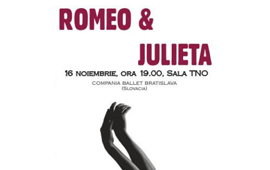> [Archived] Chronicles

A Characterless Ballet
Romeo and Juliet reconsidered
Afterwards, at the Comic Opera Theatre, Balet Bratislava performed Romeo and Juliet on Prokofiev's music. The ballet was choreographed by Mario Radacovsky and dramatised by Miroslava Kovarova, while the setting was imagined by Marek Holly and the costumes were designed by Dorota Cigankova and Diana Strauszova. It is, in fact, a reconsideration of the famous Shakespearean play, where Juliet (Veronika Holla) is constantly present on the stage and brought to the foreground. Romeo (Peter Dedinsky) is somewhat effaced as a character, being treated solely as Juliet's "companion", Mercutio's partner (probably interpreted by Arthur Abram) or Tybalt's rival (perhaps Daniel Corbeil?...), while the latter characters are far more visible and poignant as characters and much more present on stage. Some characters, such as Lorenzo or the Nurse, disappear altogether.
Furthermore, attempting to depict the setting seems a futile undertaking since the background is merely a black curtain, which opens and closes partially to allow the view of a red or orange room, where the only furnishings are a seat and a bed which eventually becomes a bier. The costumes are relatively modern, with the boys dressed in t-shirts, street outfits or tail coats and the girls wearing varicoloured, loosely-cut dresses. The lovers are obviously dressed in white, whereas Tybalt is dressed in black.
A technically limited ensemble
Besides the oversimplification of the story and the attempt to create typologies, the choreography was adapted to the limited technical abilities of the dancers by excluding complicated moves and therefore performance, and by using only a few schemes and combinations which are characteristic of group dancing. The only purpose of the ballet was seemingly that of bringing the beloved characters on stage, in an authentic and expressive performance, accompanied by a beautiful musical score played on a….CD, resulting in an agreeable evening for the amateurs and in a disappointing one for those who knew what a ballet should be like and who expected to see a renowned ballet company and an interesting choreography, at least. For my part, I could not understand why the names of the dancers were listed in the programme without specifying the role they would play. The ballet performances of the previous season were heterogeneous and even included a few eminent ones, but now Romeo and Juliet was simply performed in a style appreciated in Bratislava.
Translated by Luisa Alexandrescu and Mihaela Melneciuc
MTTLC, Bucharest University














